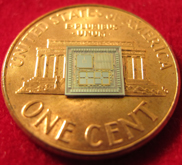Khalil Najafi receives 2013 IEEE Sensors Technical Field Award
Prof. Najafi is a world-recognized leader in the field of integrated sensors, MEMS, and microsystems.

 Enlarge
Enlarge
Khalil Najafi, Schlumberger Professor of Engineering and Chair of Electrical & Computer Engineering, received the 2013 IEEE Sensors Technical Field Award, “For leadership in microsystem technologies and seminal contributions to inertial sensors and hermetic wafer-level packaging.”
This award honors individuals with outstanding technical contributions within the scope of the IEEE Sensors Council. The Sensors Council currently consists of 23 member societies, and more than 260,000 members. Prof. Najafi was presented with the award at the 2013 IEEE Sensors Conference.
Prof. Najafi is a world-recognized leader in the field of integrated sensors, MEMS and microsystems. More specifically, he works in the areas of inertial sensors (accelerometers and gyros), implantable instrumentation for interfacing electronics to the nervous system, wafer-level packaging technology, and MEMS-based power sources.
His research as a doctoral student at Michigan led to his invention of the first practical process for implantable electrode arrays that interface with the nervous system at a cellular level. These devices came to be known as the Michigan Probes; 7500 of these devices were supplied neurophysiologists around the world during the following 20 years. More recently he has developed high-performance wireless interfaces to these systems.
Prof. Najafi reported the world’s first integrated ring gyro for measuring rate-of-turn in 1994, and has continued to pioneer advances that have dramatically improved these devices.
He has achieved world-record performance for integrated thermoelectric cryogenic coolers, micromachined vacuum micropumps, and low-frequency vibration energy harvesters. All are key components to realizing minaturized microsystems. At the time they were developed, his pizoelectric energy harvesters, which enable extended low cost operation of miniature sensors combined with minimal maintenance, converted vibrations to electricity with five to ten times greater efficiency and power than other devices in its class.

 Enlarge
Enlarge

 Enlarge
Enlarge

 Enlarge
Enlarge
Prof. Najafi’s work combining electrostatic and eutective bonding enabled microsystem packaging that would otherwise not be possible, especially for biomedical applications. Earlier this year, his group presented their research describing a fabrication process that is suitable for the extreme miniaturization and integration of future MEMS microsystems. Using this process, they built a 13 cubic mm electronic device that contains a highly-precise master clock and six sensors that detect movement in six different axes. This device could be used in place of traditional GPS to provide navigation.
Prof. Najafi co-founded two companies: Integrated Sensing Systems, Inc. (ISSYS), a company specializing in the design, development, manufacture and commercialization of innovative MEMS products,and ePack, a MEMS packaging company.
As an active member of the professional community, Prof. Najafi is often stepping up to lead or contribute to professional society activities. He has always done the same at Michigan, where he currently serves as Chair of Electrical and Computer Engineering and as Director of Michigan’s National Nanotechnology Infrastructure Network (NNIN).
He also excels in the classroom, and has received numerous teaching awards in recognition of his attention to his students, innovative courses and other contributions to education. He was named Arthur F. Thurnau Professor for Outstanding Contributions to Undergraduate Teaching, and earned the coveted HKN Teacher of the Year award, voted on by the students themselves.
Prof. Najafi earned his undergraduate and graduate degrees from the University of Michigan in electrical engineering. He is a Fellow of IEEE and the American Institute for Medical and Biological Engineering (AIMBE).
 MENU
MENU 
